Hello Fellow Readers, How about all the carpenters buzzing about – eastern carpenter bees, that is. Xylocopa virginica, the most common species, is wreaking havoc on my neighbor’s deck, not because of their yen to eat wood. Rather, they’re nesting. Please don’t hold their carpentry against them; they are pollinators in a world where pollinators are drastically in decline, dangerously so for the future of our food. (Link to a previous column, How Can it Bee? )
An exterminator mistook Lucia’s dilemma for termites.
The sawdust explosions are from carpenter bees emerging from their tunnels called galleries. They overwinter there and surface come spring to mate. Then the females gather nectar and return to build a pollen plug in a gallery chamber to lay eggs. She’ll lay one egg per chamber, often boring new tunnels in the gallery to accommodate her six to ten eggs before closing the tunnel with wood chips for her baby’s protection. Then the mom bee di s. In three months, her larvae become adults who often return to the same gallery to overwinter. That’s when you’ll see woodpeckers pecking for lunch.

Carpenter Bee (Xylocopa virginica) photo by Daniel Schwen [CC BY-SA 4.0 (https://creativecommons.org/licenses/by-sa/4.0)]
Carpenter bees are often confused with bumblebees.
Both carpenter bees and bumblebees are docile, rarely sting, and only the female carpenter bees have stingers. The stinger-less males merely bombard for protection. They are intimidating but harmless. The yellow hair on bumblebees covers most of their bodies, while carpenter bees sport yellow hair only on their upper part. Their lower part is solid black.
Like most things, the best defense is prevention. Seal crevices along your foundation and walls with caulk. Carpenter bees prefer unpainted wood in areas that get the morning s n. So, keeping up with deck maintenance is a deterrent, though oil or latex paint serves as a better restraint than deck stain.
Insecticides require a one-two punch.
Insecticides can help repel them from starting a new tunnel on the surface, but it only lasts until the rain washes it off and won’t kill those in the galleries. That’s where insecticidal dust comes in, which you can pump into the tunnels.
Only plug entry holes (about a half-inch in size) after all the bees are killed. Or in the early fall before the bees return to the gallery. If you plug the holes too soon, they’ll drill a new hole, and you’ll have an explosion of sawdust, as Lucia experienced. Using wood putty is best if you plan to paint.
As you would guess, I’m concerned about using chemicals. Even pyrethrins, a natural insecticide derived from chrysanthemums, are toxic to our essential pollinators, such as carpenter bees. Given the circumstances, an organic approach is safer when appropriately applied when pollinators are not active –in the early morning or late evening. Besides, deterring them from tunneling into Lucia’s deck will encourage them to reside in downed trees or old logs where they belong. Garden Dilemmas? AskMaryStone@gmail.com and your favorite Podcast App.
Column updated 7/2/22
A side note: Lucia learned of a bee trap resembling a carpenter’s net. The manufacturer touts, “Once the bees start filling the trap, their pheromone will start attracting other carpenter bees.” Sounds promising. I wonder if the outcome will be like the Japanese beetle bag traps that invite the neighborhood of Japanese beetles to your garden. Call me skeptical. I invite you to click through to a previous column that explains why — A Jiffy Jar of Japanese Beetles.




Mary, I plan on using paper bags to discourage wasps & hornets from building their nests under our eaves. I hope this works!
On an other subject, do you know of anything to use to heal the rotted part of our broken ornamental cherry tree? I’d love to be able to save it.
Hello Diane, Tell me more about your paper bag technique. First I’ve heard of it. :^) Regarding your cherry tree question. There’s no way to heal rotten wood of course but I would think cutting it out the best you can and treating the wound with insecticides (I prefer organic as you would guess) to help keep insects from invading the wound would be wise. Hopefully, the tree will heal itself and maybe offer up new shoots. Way back when I researched the effectiveness of sealers when my sister had a dilemma of a maple tree. I read they often help trap moisture which encourages further decay. Here’s a link to the previous column… https://askmarystone.com/proper-planting-hillside/ the sealer part is at the end. Thanks for reading my column and keep me posted on your beloved tree and paper bag technique. Looking forward, Mary